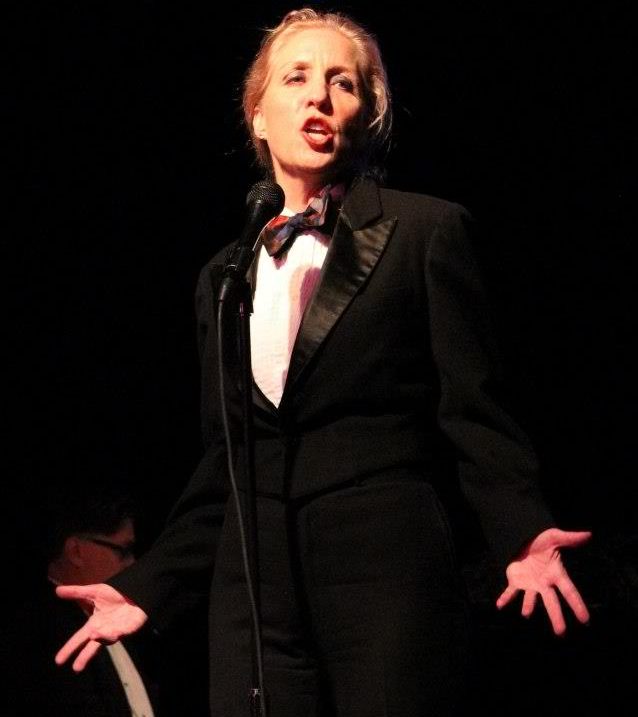Performers are revealers; we lay a thing bare.
To cultivate as broad a landscape of potential revelation as possible, we venture from the center of familiarity and recognition to the edge of mystery and uncertainty. Just as there are edges to the stage space, there are edges to us performers too. I consider the edge that place where there’s nothing to hide behind and where I feel I can’t hide even when I want to.
As a woman, I live to take myself from the center of my being out beyond myself. From center to edge and back again. With every exploration in life and every lived experience that has made it into a song or monologue, my center has expanded and my edges have pushed outward.
I’ve reveled in this edge play, in voyaging outside of my known comfort zone into a place of sticky aliveness, like that pup who is well fed at home and yet finds peculiar pleasure in the bone he sniffs out of a garbage heap at the far end of the street.
Through my work as solo singer-actress, ensemble leader and director-producer, I have endeavored to flow between these poles, always looking to push at the boundaries of the form and force the box to be wider. So in effect, my life and my art are dance partners. Sometimes life leads, sometimes art leads.
Historically, the cabaret of the French and the Kabarett of the Germans have used the mediums of music, theater, social and political satire, clowning, burlesque and erotic dance. The boundaries in this artform have been fluid, taken by artists and bent to fit any kind of light. Know where you are, so you can be somewhere else.
Freedom is what attracted me to the cabaret artform in the first place. I felt a spaciousness that I hadn’t encountered in my forays into other musical forms – classical, opera, musical theater, folk, pop. Jazz promised freedom, but only to the singer in me. Jazz didn’t scratch my acting itch. Cabaret did.
With this freedom has come the opportunity to play with the boundaries, and the responsibility to break them up. Cabaret has taught me that while something solid may frame my work, like a wall or a shaft of light, the real boundaries are imaginary. The genre itself is a challenge to existing forms, and so everything and everyone inside it is too.
As a cabaretist, I feel free to stage something known alongside something unknown, something secure behind something dangerous. To express pretty songs and ugly ones, bring comforting messages and distressing ones. As muse I may interpret, I may echo, I may rally.
One of the great benefits of daring myself to make challenging art and take challenging art is that I come through on the far side with always a greater feeling for my craft, for myself, and for my audience.
I have always respected my audience’s intelligence. Humor may vary from one culture to another, but intelligence is universal and I feel a responsibility to that intelligence, mental and emotional, in myself and in my audience. I try to be sincere in my work and that means pleasing and entertaining myself first, and challenging myself first. For when I am willing to risk my own sensibilities and expectations, I create the opening for my audience to do the same. And the circle is made.
My job as a theater artist is to remind people of what they’ve dismissed, forgotten or buried. Performance is not about only pleasure. It’s actually about ritual and sacrifice. You have to go through something as an audience member. It means you will be uncomfortable and that’s okay. You’ll also be taken care of.
– Taylor Mac
I’ve been fortunate to have producers who have given me a job and a stage, and then stepped away. And I’m excited as hell to work with these people, because they don’t know what they’re going to get. They’re going on a hunch with me…”give it to Kohler, she loves that shadow stuff.” Their trust is immensely empowering and freeing. They’re the brave ones, and immediately the collaboration feels honest and promising. It’s the only way I really like to work, really can work. I have to have that liberty or it becomes about pleasing someone else and that necessarily entails self-censorship. Feeling beholden to someone puts a sure brake on the vehicle of art.
It’s a similar thing when I am in the producer’s chair. If it’s the Kabarett Kollektif I’m leading, I will come with a vision or a theme because in a group setting we have to feel our common thread. But as soon as possible I want to step away and prepare to be delighted, surprised, challenged, and moved. Directing another artist is about stewarding their vision. I grasp it, they trust me to hold it. Should they wander, I nudge them back. Mostly I witness. I am a hard boundary, a buoy, in their sea of possibility.
We players, venues, producers and patrons are all in service to the call of art. Where it’s the other way around and art is made to serve our needs, where a producer or venue sets limits on what can be expressed, all that is a set up for a slow death for everyone involved. It’s suffocating, and we all know the feeling when the oxygen is scarce. It sucks.
Art must be free. Engagement and connection happen when art is free – free to soothe and free to challenge. When its edges serve as pointers to the centermost place in each of us that we all recognize.
Art is there to be spoken.
Rules are there to be broken.
Create by rules alone.
Your art sinks like a stone.

Leave A Comment